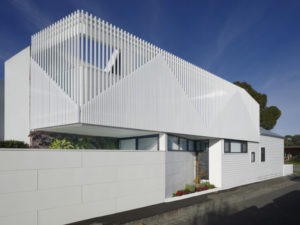Project Description
The House in Frogs Hollow, a 2000-square-foot country retreat, is located on a long slope of the Niagara Escarpment overlooking Georgian Bay. The site is a collection of eroded clay hills and protected watershed zones blanketed with a dense field of hawthorn and native grasses. It is not picturesque, but tough and impenetrable.
The clients, who spend time at the property throughout the year, are avid cyclists who spent months on the 100- acre property prior to construction, forging discreet mountain biking trails and getting to know thepaths of the horses and snowmobiles in different seasons. Because of their affinity for the landscape, the primary site strategy was to resist the temptation to build on top of the hills, where one could survey the site in its entirety, and instead to carve out a building area at the base of the hillside. The house is not the final destination, but a stopping place within their network of activity.Carved into the landscape, the powerful tectonic of the long concrete wall figuratively prepares the site for building, while bridging the natural environment. The concrete has a toughness that mirrors the landscape, providing shelter from the prevailing winter winds. During the summer months, the wall provides shade for the patio, creating pools of cooler air that are passively drawn through the house.
Entry is at the west end of the concrete wall and into a service area comprising the stairs, kitchen, office, bike workshop, storage room, and technical room. This functional zone serves as a backdrop to the glazed living area that opens up on three sides to an extensive view of the rolling landscape.
The second level hovers above the concrete wall and living space. It contains the bedrooms, bathrooms, and family room. The first and second floors are connected by a stairwell. This digitally fabricated element is designed to filter light from the clerestory above. On the ground floor it allows more space at the entrance and for a seating area.
The connection of the house to the land is reinforced not only by its architectural form, but also by its environmental footprint. The house is heated with a radiant floor system that supplements the passive winter heat gain from south-facing windows. In addition, there is no mechanical cooling. Instead, the stair tower and operable windows facilitate passive ventilation that draws cool air through the house from shaded exterior areas. Natural materials and pigments were used throughout and the house occupies a small square footage to further reduce construction costs and keep future energy consumption to a minimum.






























































